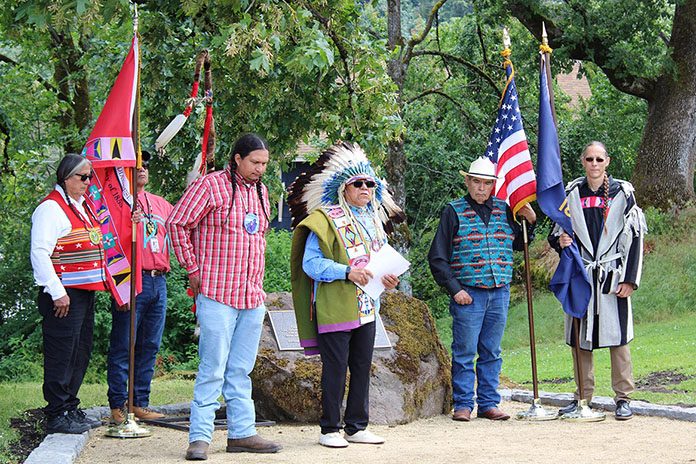
The Confederated Tribes of the Umatilla Indian Reservation (CTUIR) and Oregon City officials on Monday, June 3 honored five Cayuse men who were wrongfully arrested and executed there in the 19th century.
More than 100 people, including CTUIR members and local leaders, withstood cool temperatures and strong winds to honor the men by dedicating a historical interpretive panel and boulder at McLoughlin Promenade, a park overlooking the location of the men’s public hanging in 1850 near Willamette Falls. The site’s proximity to where the men were detained, tried and hanged was carefully considered by Oregon City officials and is of importance to the CTUIR.
“The five Cayuse men that we are remembering today have a very important role in the history of the Cayuse people. We are here because of these five men who gave their lives for the future of their people. They made the ultimate sacrifice,” said CTUIR Chairman Gary I. Burke during the ceremony. “Their last breaths were here in Oregon City, on this day, June 3, 174 years ago. For more than three decades, individuals from our Confederated Tribes of the Umatilla who descend from the families of these men, leaders and headmen, and elected officials have worked to remember these five men, their lives and their deaths.”
“Honoring these five men in this way reflects our love and respect for our ancestors who made sacrifices so we could be here, for the leaders who made this tribute possible and for those who carry on the work our elders directed us to continue, said CTUIR Board of Trustees Member at Large Toby Patrick.

A plaque on the boulder presents a message of hope that the men’s burial location will be found: “This land hears our prayers. This land bears witness to all that happens here. The names of the five elders who died here are not forgotten. Their names echo across the Earth as we speak them. These ancestors are buried nearby, far from their homeland. Our families long to bring them home. Perhaps the land where they are buried will reveal itself. We continue to pray for these relatives.”
Efforts to identify the men’s graves are ongoing but are challenged by conflicting historical accounts of the location as well as changes in infrastructure and landscape over time.
The interpretive panel lists the names of the five men and tells the story of why they went to Oregon City.
According to CTUIR historians, Marcus Whitman, who established the Whitman Mission in the Walla Walla Valley, was suspected of coveting Cayuse lands and spreading disease among the Cayuse people in 1847. Thirteen people, including Whitman, were killed at the mission when Cayuse tribesmen attacked it on Nov. 29, 1847. Following Whitman’s death, a militia formed and launched what came to be known as the Cayuse War.
In 1850, five Cayuse men volunteered to talk about the Whitman Mission killings and were subsequently arrested, tried and hanged. Those five men were Tiˀílakaˀaykt, ˀIceyéeye Siléis, ooá Šaqíin, Tamáhas and ƛókomooc. (The names are represented with standard Americanist symbols.)
In 1991, then-CTUIR Board Trustee Armand Minthorn began working with former Oregon City Mayors Dan Fowler and Alice Norris on ways to honor the men. Subsequently, átway (late) CTUIR Trustee Les Minthorn, who carried the family name ooá Šaqíin, told at least two Oregon City groups that approached the CTUIR with ideas of reconciliation and dramatic re-enactment that what the CTUIR most wanted was to find his “ancestors and bring them home for proper burial.” Both Minthorns descend from the families of the hanged men.
In 2021, the Oregon City Commission approved funding to construct the tribute project. Construction began May 6, 2024, and finished shortly before the June 3 dedication.
“We are here today to acknowledge a wrong that occurred in our community in 1850 and its part of our collective history. We are here to reflect and to never forget,” Oregon City Mayor Denyse McGriff said during a reception at the Museum of Oregon Territory after the ceremony.
She and city commissioners then read a proclamation recognizing June 3, 2024, as the Cayuse Five Day of Remembrance in Oregon City.










